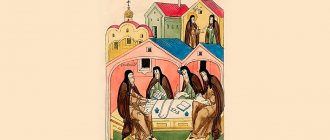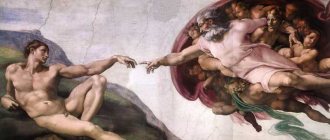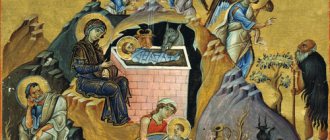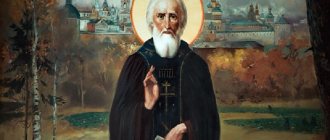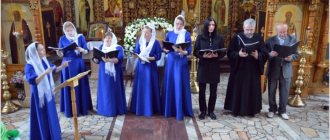LiveInternetLiveInternet
Yuletide and Christmas stories in Russian literature of the 18th-21st centuries.
Wonderful winter holidays have long included, and probably still include, ancient folk Christmastide (pagan in origin), the church holiday of the Nativity of Christ, and the secular holiday of the New Year.
Literature has always been a reflection of the life of the people and society, and the mysterious Christmas theme is simply a treasure trove of fantastic stories that convey the world of the wonderful and otherworldly, always bewitching and attracting the average reader.
Christmastide, in the succinct expression of A. Shakhovsky, is “evenings of national fun”: fun, laughter, mischief are explained by a person’s desire to influence the future (in accordance with the proverb “as you begin, so you end” or with the modern one - “how you celebrate the New Year, That’s how you’ll get through it”).
It was believed that the more fun a person spends the beginning of the year, the more prosperous the year will be...
Artist A. Emelyanov “Christmastide”
However, where there is excessive laughter, fun, fervor, it is always restless and even somehow alarming... This is where an intriguing plot begins to develop: detective, fantastic or simply romantic... The plot is always dedicated to Holy Days - the time from Christmas to Epiphany .
In Russian literature, the Yuletide theme began to develop from the middle of the 18th century: at first there were anonymous comedies about games, Yuletide tales and stories. Their characteristic feature was the long-standing idea that it is during the Yuletide period that “evil spirits” - devils, goblins, kikimoras, banniki, etc. - become most active. This emphasizes the hostility and danger of Yuletide time...
Fortune-telling, caroling by mummers, and dish songs became widespread among the people. Meanwhile, the Orthodox Church has long condemned such behavior as sinful. The decree of Patriarch Joachim of 1684, prohibiting Yuletide “possessions,” says that they lead a person into “soul-destructive sin.” Yuletide games, fortune-telling and mummery (“mask-playing”, putting on “animal-like mugs”) have always been condemned by the Church.
Subsequently, a need arose for folk Christmas tales and stories to be processed literary. Writers, poets, ethnographers and folklorists began to engage in these activities, in particular M.D. Chulkov, who published the humorous magazine “Both and Sio” throughout 1769, and F.D. Nefedov, from the end of the 19th century. who published magazines with a Christmas theme, and, of course, V.A. Zhukovsky, who created the most popular Russian ballad “Svetlana”, which is based on a folk story about a heroine fortune-telling at Christmas time...
Many poets of the 19th century also turned to Christmas themes: A. Pushkin (“Fortune telling and Tatiana’s Dream” (excerpt from the novel “Eugene Onegin”), A. Pleshcheev (“The Legend of the Child Christ”), Y. Polonsky (“Yolka” ), A. Fet (“Fortune telling”), etc.
Gradually, during the development of romanticism, the Christmas story attracts the whole world of the miraculous. Many stories are based on the miracle of Bethlehem, and this is the transformation of just a Christmas story into a Christmas story...
The Christmas story in Russian literature, unlike Western literature, appeared only in the 40s. XIX century This is explained by the special role of the holiday, which is different from Europe.
Christmas Day is a great Christian holiday, the second most important after Easter.
For a long time in Russia, the world celebrated Christmastide, and only the Church celebrated the Nativity of Christ.
In the West, the Christian tradition became much earlier and more closely intertwined with the pagan one; in particular, this happened with the custom of decorating and lighting a Christmas tree for Christmas. The ancient pagan rite of veneration of the tree turned into a Christian custom. The Christmas tree became a symbol of the Divine Child. The Christmas tree entered Russia late and took root slowly, like any Western innovation.
From the middle of the 19th century. The appearance of the first stories is also associated with Christmas themes. Earlier texts, such as “The Night Before Christmas” by N.V. Gogol, are not indicative; firstly, Gogol’s story depicts Christmastide in Ukraine, where the celebration and experience of Christmas was closer to the Western one, and secondly, Gogol, the pagan element (“devilishness”) prevails over the Christian.
Another thing is “Night at Christmas” by the Moscow writer and actor K. Baranov, published in 1834. This is really a Christmas story: the leading motive in it is mercy and sympathy for the child - a typical motive of the Christmas story.
The massive appearance of such texts was observed after the Christmas stories of Charles Dickens from the early 1840s were translated into Russian. - “A Christmas Carol”, “Bells”, “Cricket on the Stove”, and later others.
These stories were a huge success among Russian readers and gave rise to many imitations and variations. One of the first writers to turn to the Dickenian tradition was D.V. Grigorovich, who published the story “Winter Evening” in 1853.
“The Lord of the Fleas” and “The Nutcracker” by Hoffmann and some of Andersen’s fairy tales, especially “The Christmas Tree” and “The Little Match Girl,” played an important role in the emergence of Russian Christmas prose.
The plot of the last fairy tale was used by F. M. Dostoevsky in the story “The Boy at Christ’s Christmas Tree”, and later by V. Nemirovich-Danchenko in the story “Stupid Fedka”.
The death of a child on Christmas night is an element of phantasmagoria and a too terrible event, emphasizing the crime of all humanity against children...
But from a Christian point of view, little heroes acquire true happiness not on earth, but in Heaven: they become angels and end up on the Christmas tree of Christ Himself. Actually, a miracle occurs: the miracle of Bethlehem repeatedly affects the destinies of people...
Later, Christmas and Yuletide stories were written by almost all major prose writers from the 19th century to the present day. XX centuries Yuletide and Christmas stories could be funny and sad, funny and scary, they could end with a wedding or the death of heroes, reconciliation or a quarrel.
But with all the diversity of their plots, they all had something in common - something that was in harmony with the festive mood of the reader, sometimes sentimental, sometimes uncontrollably cheerful, invariably causing a response in the hearts.
Each such story was based on “a small event that had a very festive character” (N.S. Leskov), which made it possible to give them a general subtitle. The terms “Christmas story” and “Yuletide story” were, for the most part, used as synonyms: in texts under the heading “Yuletide story” motifs associated with the holiday of Christmas could predominate, and the subtitle “Christmas story” did not at all imply the absence of folk motifs in the text Christmas time...
The best examples of the genre were created by N.S. Leskov. In 1886, the writer wrote a whole cycle of “Yuletide Stories.”
In the story “The Pearl Necklace,” he reflects on the genre: “It is absolutely required of a Christmas story that it be timed to coincide with the events of the Christmas Eve - from Christmas to Epiphany, that it be somewhat fantastic, have some kind of moral... and, finally - so that it certainly ends cheerfully.
There are few such events in life, and therefore the author is forced to invent himself and compose a plot suitable for the program.”
Both “Vanka” and “On Christmastide” by A.P. Chekhov are unique Yuletide stories.
In n. XX century, with the development of modernism in literature, parodies of the Yuletide genre and humorous recommendations on how to write Yuletide stories began to appear.
So, for example, in the newspaper “Rech” in 1909, O.L.D”or (Orsher I.) published the following guide for young writers:
“Any person with hands, two kopecks for paper, pen and ink and no talent can write a Christmas story.
You just need to adhere to the well-known system and firmly remember the following rules:
1) Without a pig, a goose, a Christmas tree and a good man, a Christmas story is not valid.
2) The words “manger”, “star” and “love” should be repeated at least ten, but no more than two to three thousand times.
3) The ringing of bells, tenderness and repentance should be at the end of the story, and not at the beginning of it.
All the rest does not matter".
The parodies indicated that the Yuletide genre had exhausted its possibilities. Of course, one cannot help but note the interest in the spiritual sphere among the intelligentsia of that time.
But the Yuletide story moves away from its traditional norms. Sometimes, as, for example, in V. Bryusov’s story “The Child and the Madman,” it provides an opportunity to depict mentally extreme situations: the miracle of Bethlehem as an unconditional reality in the story is perceived only by the child and the mentally ill Semyon.
In other cases, Christmas works are based on medieval and apocryphal texts, in which religious moods and feelings are especially intensively reproduced (the contribution of A.M. Remizov is important here).
Sometimes, by reproducing the historical setting, the Yuletide plot is given a special flavor (as, for example, in the story by S. Auslander “Christmastide in Old Petersburg”), sometimes the story gravitates towards an action-packed psychological novel.
The traditions of the Christmas story were especially honored by A. Kuprin, creating excellent examples of the genre - stories about faith, goodness and mercy “The Poor Prince” and “The Wonderful Doctor”, as well as writers from Russia abroad I. A. Bunin (“Epiphany Night”, etc.) , I.S. Shmelev (“Christmas”, etc.) and V. Nikiforov-Volgin (“Silver Blizzard”, etc.).
In many Christmas stories, the theme of childhood is the main one. This theme is developed by the statesman and Christian thinker K. Pobedonostsev in his essay “Christmas”: “The Nativity of Christ and Holy Easter are primarily children’s holidays, and in them the power of Christ’s words seems to be fulfilled:
Unless you are like children, you cannot enter into the kingdom of God. Other holidays are not so accessible to children’s understanding...”
And then Konstantin Petrovich develops the idea of children’s imagination, receptive to the entire Gospel story and, in particular, to simple stories about the Nativity of Christ:
“A quiet night over the Palestinian fields, a secluded den, a manger. Surrounded by those domestic animals that are familiar to the child from the first impressions of memory - in the manger the entwined Baby and above Him the meek, loving Mother with a thoughtful gaze and a clear smile of maternal happiness - three magnificent kings following a star to a wretched den with gifts - and in the distance on the field there are shepherds in the middle of their flock, listening to the joyful news of the Angel and the mysterious choir of the Heavenly Forces.
Then the villain Herod, pursuing the innocent Child; the massacre of the infants in Bethlehem, then the journey of the holy family to Egypt - how much life and action there is in all this, how much interest for a child!”
And not only for a child... Holy days are such an amazing time when everyone becomes children: simple, sincere, open, kind and loving to everyone.
Later, and not surprisingly, the Christmas story was “revolutionarily” transformed into a New Year’s story. New Year as a holiday replaces Christmas, and the kind Father Frost comes to replace Christ the Child...
But the state of awe and expectation of a miracle is also present in the “new” stories. “Christmas tree in Sokolniki”, “Three assassination attempts on V.I. Lenin” by V.D. Bonch-Bruevich, “Chuk and Gek” by A. Gaidar are some of the best Soviet idylls. There is also no doubt that E. Ryazanov’s films “Carnival Night” and “The Irony of Fate, or Enjoy Your Bath” are oriented towards this tradition...
Yuletide and Christmas stories are returning to the pages of modern newspapers and magazines. Several factors play a special role here.
Firstly, the desire to restore the broken connection of times, and in particular, the Orthodox worldview.
Secondly, to return to many of the customs and forms of cultural life that were so violently interrupted.
The traditions of the Christmas story are continued by modern children's writers S. Serova, E. Chudinova, Yu. Voznesenskaya, E. Sanin (Mon. Varnava), etc.
Christmas reading has always been a special reading, because it is about the sublime and non-vain.
Holy days are a time of silence and a time for such pleasant reading.
After all, after such a great holiday - the Nativity of Christ - the reader simply cannot afford anything that would distract him from high thoughts about God, about goodness, mercy, compassion and love...
Let's take advantage of this precious time!
Prepared by L.V.Shishlova
Used Books:
1.The Miracle of Christmas Night: Christmas Stories / Comp., intro. Art., note. E. Dushechkina, H. Barana. – St. Petersburg: Artist. Lit., 1993.
2.Star of Bethlehem. Christmas and Easter in poetry and prose: Collection / Comp. and joined M. Pismenny, - M.: Det. lit., - 1993.
3.The Star of Christmas: Christmas Stories and Poems / Comp. E.Trostnikova. – M.: Bustard, 2003
4.Leskov N.S. Collection Op. in 11 vols. M., 1958. t.7.
source
From medieval mystery to literature
The tradition of the Christmas story originates in medieval mystery plays. These were dramas on biblical themes. The implied three-level organization of space (hell - earth - heaven) and the general atmosphere of a miraculous change in the world or a hero passing through all three stages of the universe in the plot of the story passed from the mystery into the Christmas story.
In Rus', the predecessors of the literary Yuletide story were oral stories, or tales, usually told in villages on Yuletide evenings.
Christmastide, the period from Christmas to Epiphany, was considered one of the largest and noisiest holidays of peasant life, combining riotous fun and human fear of the forces of darkness. According to popular beliefs, evil spirits acquired special power at this time and walked freely across the earth. However, according to the general opinion, they could not only harm, but also possessed knowledge of the future; Overcoming fear, the man tried to find out his fate from them. In order for the spirits to answer the most interesting question - and this is usually the question of future marriage - there were many fortune tellings. They were often accompanied by terrible stories - about a fortune-telling that came true, about the betrothed being twisted, about a clash with evil spirits. Elderly, experienced women told them to young fortune tellers. Then echoes of such stories will turn into a literary Christmas story. Most often in these stories, mysterious visitors from the other world appear face to face with a person. “If in the famous “Terrible Fortune-Telling” by A. Bestuzhev-Marlinsky or in the “Hussar Saber” by K. Barantsevich, fortune-telling indeed fatally influences the fate of the heroes, then in the anonymous “Yuletide Story,” published in 1892 by the children's almanac “Bylinka,” fortune telling with a mirror turns out to be just a funny adventure,” writes Maya Kucherskaya in the preface to the collection of Christmas stories.
Christmastide of the XXI century
Today is the time to remember warm and touching stories. It is especially important that these stories were never hidden in separate “children’s” and “adult” sections of magazines and almanacs. These are stories for family, home reading. Before a miracle there are no children and adults, young and old. At Christ's holiday there will be no conflict between fathers and children. News from this bright world - stories about why the Christmas tree is decorated at Christmas (because only it stands in the forest forever green, and therefore indicates eternal life), why all people and even all animals rush not only to worship the Divine Infant, but also to help those who got lost on the way to His den.
Here it is, the purpose of the Christmas story is to strengthen the festive atmosphere in the homes of readers, tearing them away from everyday worries, at least on Christmas Day to remind them of all those who “toil and are burdened”, of the need for mercy and love.
First published January 7, 2009
A heart-warming holiday
It is not for nothing that most stories take place on Christmas night, when heaven and earth worship the Baby lying in the nativity scene. At this time, everything is transformed, evil hearts soften, and the songs of angels become audible to people. So in Christmastide stories, not only the action of evil spirits is obvious to humans. Angels, the Mother of God and Christ Himself take an active part in the events of our lives. In both Europe and Russia, special almanacs with such stories were published for the holiday. Here crafty spirits and angels found themselves under one cover.
The mysticism of the Incarnation called us to look back at the miracles that were happening on earth and to create at least a small miracle ourselves. In many stories, fear of the unknown turned into a feeling of tenderness and pity for the weak and defenseless. “The first Christmas stories of this type appeared in Europe, and not by chance: the Catholic and Protestant West always felt more acutely the need to bring sacred events and characters as close as possible to themselves, therefore the celebration of Christmas quickly acquired here not only religious, but also everyday, home significance. The pitiful Christmas stories were very successfully adapted and translated the holiday from spiritual to spiritual human language,” says Maya Kucherskaya. These are, for example, the stories of Dickens, reflecting purely English ideals of comfort and home. The specifics of the Dickensian tradition required a happy, even if not logical and implausible, ending, affirming the triumph of goodness and justice, reminiscent of the gospel miracle and creating a wonderful Christmas atmosphere.
Stories usually begin with a description of injustice, incompleteness, crisis. Freezing orphans, driven to despair, and travelers were lost in the storm, choking on their tears. Ghosts glided like vague shadows, the betrothed with a terrible smile looked at the bride from the flickering mirror space, a lonely old man repentantly recalled the years he had lived, an unhappy lover was thinking about suicide, a cut down Christmas tree yearned for a free life in the forest. But it is clear that because this happened on the night before the Nativity of Christ, on the great night of salvation, no one remained inconsolable. By the grace of Providence, the orphan met her benefactor, and the poor man received an inheritance, and the traveler heard the ringing of a bell through the snowstorm. Miracle enters people's lives. In contrast, realistic works were often created that combined evangelical motifs and the basic genre specificity of the Christmas story with an enhanced social component. Among the works of Russian writers written in the genre of Christmas stories is “The Boy at Christ’s Christmas Tree” by F. M. Dostoevsky.
An ordinary miracle
We have already said that Christmas stories often begin with a description of the misfortunes and difficulties of human existence. A grandmother, barely making ends meet, has nothing to please her grandchildren for the holiday (“Christmas Tree”), a mother is unable to buy a gift for her child (P. Khlebnikov, “Christmas Gift”), and the inhabitants of a St. Petersburg slum have no money for a tree (K. Stanyukovich, “Yolka”), a gifted young man
we are undeservedly oppressed by our stingy uncle (P. Polevoy, “Slavelytsy”), a forced peasant, at the whim of the master, must kill his pet bear (N.S. Leskov, “The Beast”), having lost his train ticket, the old woman cannot get to her dying son ( A. Kruglov, “On the Eve of Christmas Eve”). However, there is always a way out, all obstacles are overcome, obsessions are dispelled.
A miracle is not necessarily associated with events of a supernatural order - a visit from angels or Christ (although this also occurs); much more often it is an everyday miracle, which can be perceived simply as a successful coincidence, as a happy accident. However, for stories based on the gospel system of values, accidents are not accidental: in any successful combination of circumstances, both the author and the characters see merciful heavenly guidance.
It is interesting that harmony is sometimes achieved even at the cost of death, and the author usually does not leave the hero on its threshold, entering the heavenly abodes with him - the description of his “posthumous” bliss seems to balance the hardships of earthly existence. For the little hero F. Dostoevsky, death itself becomes the door to the land of his cherished desires, where he finds everything that he really lacked - light, warmth, a luxurious Christmas tree, the loving gaze of his mother. It was “The Boy at Christ’s Christmas Tree” that became, perhaps, the most famous Russian Christmas story.
From the eighteenth century to the future
In Russia, the first Christmas stories appeared on the pages of the unique 18th-century magazine “Both and This.” His publisher, M.D. Chulkov, placed here a wide variety of materials on ethnography: songs, proverbs, sayings. At the same time, for Easter, a household sketch was printed describing the Easter festivities; for Christmastide - texts of special songs and, of course, Christmas tales. Chulkov retold them with a considerable amount of irony, inserting his own comments and explanations.
The people's world became truly interesting to writers a little later. The romantics of the 19th century valued all kinds of originality, both in foreign cultures and in their own. Romantics were fascinated by the mystical aura of Christmas time, which allowed them to develop plots in a direction close to romanticism - fantasy, mystery, contact with otherworldly forces, aestheticization of horror. To the descriptions of terrible fortune-telling, city stories about encounters with ghosts and black magic sessions have also been added. However, soon such phenomena began to be described in an ironic manner, and often ghosts turned out to be nothing more than the result of an inventive prank.
The Christmas story, despite the diversity and numerous texts belonging to different eras and different writers, is nevertheless very easily recognizable. In the most general form, one can define a Christmas story as a story about a miracle that happened during the winter holidays.
From the Western world to Russia
The founder of the Christmas story genre is considered to be Charles Dickens, who set the basic tenets of the “Christmas philosophy”: the value of the human soul, the theme of memory and oblivion, love for “man in sin,” and childhood. In the mid-19th century, he composed several Christmas stories and began publishing them in the December issues of his magazines “Home Reading” and “Round the Year”. Dickens combined the stories under the title “Christmas Books.” “A Christmas Carol in Prose: A Yuletide Ghost Tale”, “The Bells: A Tale of the Spirits of the Church Clock”, “The Cricket on the Hearth: A Tale of Family Happiness”, “The Battle of Life: A Tale of Love”, “Possessed, or a Deal with a Ghost” - all these works are densely populated with supernatural creatures: angels and various evil spirits. The tradition of Charles Dickens was adopted by both European and Russian literature. “The Little Match Girl” by G.H. is also considered to be a striking example of the genre in European literature. Andersen. Miraculous salvation, the rebirth of evil into good, the reconciliation of enemies, the forgetting of grievances are popular motifs in Christmas and Yuletide stories.
